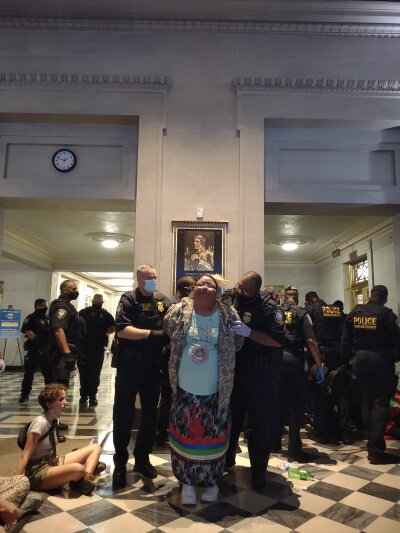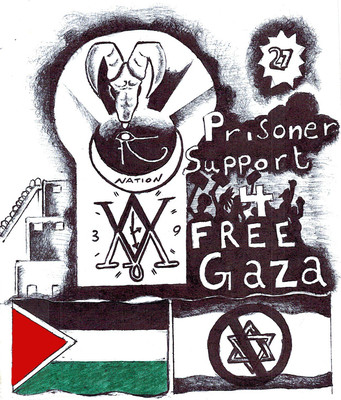Taking Kabul
On Thursday, 12 August 2021, CNN reported that Afghanistan’s capital
of Kabul would fall into the hands of the Taliban in 30 to 60 days.(1)
On Sunday the 15th (only 3 days later!) the Taliban took control of
Kabul. One day after that, the chief comprador leader of the Islamic
Republic, Ashraf Ghani, fled the country on an airplane.
As thousands stormed the capital’s airport to flee the country from
the Taliban takeover, U.$. soldiers escorting Amerikan personnel shot
and killed two Afghanis on the tarmac of Kabul International Airport.(2)
Video footage captured citizens hanging onto the side of the airplane
and falling off mid-departure.
In regards to the humiliating end note of their 20 years war, the
National $ecurity Advisor pig Jake Sullivian said the following:
“Despite the fact that we spent 20 years and tens of billions of
dollars to give the best equipment, the best training and the best
capacity to the Afghan security forces, we could not give them the will
and they ultimately decided that they would not fight for Kabul and they
would not fight for the country.”(3)
U.$. imperialism and the “democracy” they claim to spread around the
world propped up the extremely reactionary government of the now fallen
Islamic Republic. Despite wimmin’s rights having been a focal excuse for
the imperialists to invade Afghanistan, their puppets in the Islamic
Republic had no meaningful difference in wimmin’s rights in
Afghanistan.
To the U.$. imperialists, their defeat (while surprising in how
quickly Kabul fell) did not come as shock. On Saturday, 29 February
2020, (around a year and half before the fall of Kabul) the United
$tates and the Taliban met in a five star hotel in Qatar and signed
agreements to end the 20 years war.(4) One of the primary points of the
agreements was complete withdrawal of U.$. troops within 14 months.(5)
It seems that this is one of the rare agreements in which Amerikans made
a promise and actually kept it with an oppressed nation. Other
agreements included Taliban’s refusal to “terrorist groups” such as
Al-Qaeda to use Afghanistan’s territory as operation grounds, and
lifting of U.$. sanctions on the country.
The Sober Taliban?
In the Amerikan press, there were two big talking points around their
defeat in Afghanistan. One was the would-be refugees trying to flee
Afghanistan into the arms of Amerika, which nicely reinforces the story
that Amerikans were the saviors in the country after all. The second was
how wimmin would fair when the Taliban took over again. This reinforces
the justification for invading Afghanistan to have been to liberate
wimmin from gender oppression, a point that continues to serve U.$.
militarism even after a failed 20 year war. A point that had nothing to
do at all with why the U.$. invaded.
The Taliban is not unaware of these perceptions, leading to their
representatives at the peace negotiations to suggest for less backwards
treatment of wimmin under their rule.(6) Zabihullah Mujahid has claimed
that they will “honor women’s rights,” and the “independence of private
media” (journalists, news organizations, etc.).(7)
Mujahid’s comment highlights an important part of the Taliban’s new
look (and most importantly, their class character). As rising from the
bourgeois nationalist position, they were part of a country-wide Islamic
movement to usurp warlord factions which ruled Afghanistan. The warlords
themselves rose with western aid to usurp Soviet social-imperialist
compradors led by Mohammad Najibullah. Mohammad Najibullah also started
out with bourgeois nationalist tendencies usurping monarchist
compradors.
After coming to power in the 1990s, the Taliban were overthrown by
the U.$. imperialists themselves in the early 2000s after seeking to
bite the hand that fed them decades before. Now, in 2021, they have
risen to the seat again in Kabul. In order to maintain legitimacy, they
must seek acceptability to new potential imperialist sponsors. If that
means talking the talk to become the neo-colonial semi-feudal comprador
state that the puppet regime beforehand never lived up to, then they
must do it out of tactical necessity. Despite this tricky position that
they have found themselves in, the United $tates’ do not seem to be the
number one contender as Afghanistan’s neo-colonial ruler.
Upon the line of which class interest is at the helm of Afghanistan’s
liberation from the United $tates’, we should also emphasize that under
the leadership of the national bourgeois there was also the
petty-bourgeoisie, the peasantry, and the agricultural proletariat
within the Taliban movement. This character of Afghanistan’s national
liberation gives time and space for the Afghan masses to breathe and
provide necessary conditions for discussions on the country’s past,
present, and future: what is to be done? What were the historical
conditions that led up to colonial exploitations and humiliation? What
does our liberation from the U.$. imperialists mean today? These
questions will be further asked during the transformation of subjective
and objective forces by revolutionaries.
The
Social-Imperialist Road to Afghanistan
China was one of the first major imperialist countries to recognize
the Taliban as the legitimate government of Afghanistan and the Islamic
Emirate of Afghanistan as a legitimate country.(8) It is nothing new for
social-imperialism (not only in Afghanistan but for the whole world) to
hijack bourgeois nationalist movements and turn them into satellite
states. The number one tactic of Soviet social-imperialism was through
neo-colonial aid, and China seems to be using the same tactic. China’s
foreign minister Wang Yi said on September 8th, only a few weeks after
the Taliban’s victory, that they will be providing the Taliban
government $31 million dollars equivalent in food and aid.(9)
While publicly declaring their $31 million dollar deal with the
Taliban, Wang Yi has also expressed calls for the Taliban to combat and
remove the Uyghar jihadist movements of Xinjiang province – primarily
the Turkestan Islamic Party (TIP). Where China borders Afghanistan, the
Xinjiang province is where most Uyghars reside (a majority Muslim
national minority group of China facing oppression). The Turkestan
Islamic Party – which has had historical alliances with the Taliban of
Afghanistan – poses a major threat to the stability of capitalist China
alongside the general Uyghar minority group. As a group who once
declared liberation for the Muslim world, the Taliban will now have to
be in a position of being the agents for Chinese social-imperialism
against fellow Muslim nations/organizations. This is the limit to
Jihadism as an anti-imperialist force (and other bourgeois nationalist
anti-imperialisms) and the poisonous consequences of social-imperialism.
Without Marxism-Leninism-Maoism, liberated countries will only fall back
to colonialism.
Long Live Afghanistan
The United $tates’ defeat in Afghanistan, and the Taliban’s victory
is a victory for the Afghan people. For the first time, Afghanistan
could have a chance of being an independent nation state in our modern
capitalist era. However, foreign meddling by the Amerikans, Chinese and
others continue to threaten the development of Afghanistan’s
self-determination. It is only by continuing down the road of
independence that questions of economics, gender and the urban/rural
divide in the country can be adequately addressed. The Taliban has
served as a historically important and necessary opponent of foreign
occupation, but the Afghan people need more than that to continue to
address the contradictions they face as a nation. Revolutionaries here
in the United $tates must continue to oppose our government’s
interference in that progress.
Long Live Afghanistan!
Down with world imperialism!
Notes
1. Barbara Starr, “Intelligence assessments warn Afghan
capital could be cut off and collapse in coming months,” CNN, 12 August
2021.
2. Rebecca Klapper, “U.S. Military Fatally Shoots 2 at Kabul
Airport as Biden Orders in 1,000 Additional Troops,” Newsweek, 12 August
12, 2021.
3. Ibid.
4. Saphora Smith, “U.S.-Taliban sign landmark agreement in
bid to end America’s longest war,” MSNBC, 29 February
2020.
5. Ibid.
6. Amanda Thub, “Why the Taliban’s Repression of Women May
Be More Tactical Than Ideological,” The New York Times, 4 October
2021.
7. Associated Press, “The Taliban Claim They’ll Respect
Women’s Rights — With Their Reading Of Islamic Law,” NPR, August 12,
2021
8. Memri, “During September, China-Taliban Relations
Continued To Strengthen,” 5 October 2021.
9. Helen Reagan, “China to provide Afghanistan with $31
million worth of food and Covid vaccines,” CNN, 9 September
2021.











